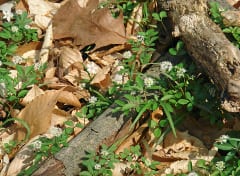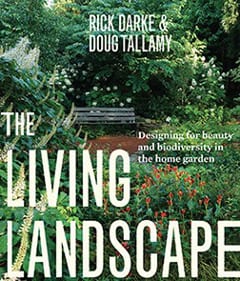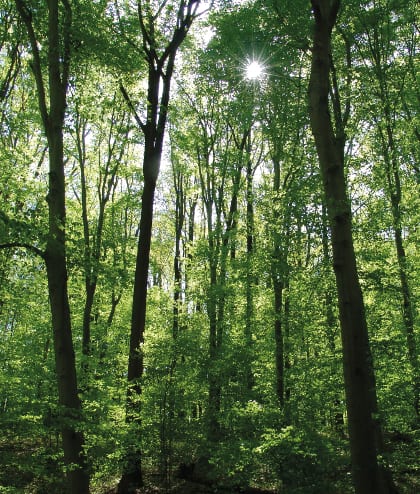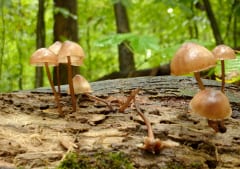 by Rick Darke and
by Rick Darke and
Doug Tallamy
Taken from The Living Landscape: Designing for Beauty and Biodiversity in the Home Garden (c) Copyright 2014 by Rick Darke and Doug Tallamy. Published by Timber Press, Portland, OR. Used by permission of the publisher. All rights reserved.
The following excerpt focuses on the Ground Layer, only one of the many layers of the landscape.
What does a richly layered landscape look like? This chapter (Chapter 1) reflects upon the layers often found in natural habitats and other landscapes beyond the deliberate influence of human activity, illustrating patterns and processes that can serve as models and inspiration for making and maintaining ecologically healthy residential gardens.
Learning to recognize and read the layers in any landscape is enjoyable and useful. As the layered organization of a landscape becomes apparent, it provides a framework for more detailed observation and understanding. This framework helps us to appreciate the richness and complexity without being overwhelmed by it.
Knowing where to look for elements and events in the life of any layer is an enduring pleasure. An increasing ability to comprehend interactions between elements in the layers makes it ever more possible to recognize stability or to anticipate change, and to perceive the influence of internal and external forces on living systems. Gardens have layers, too, and an appreciation of patterns and processes in unmanaged systems is a powerful tool for deciding how and when to emulate or intervene in the landscape each of us calls home.
Adopt the perspective of landscapes being comprised of layers and it quickly becomes obvious that some layers are more literal than others. Layers that accumulate through the influence of human culture—the cultural layers—are often more conceptual in nature, and can’t always be identified by defined spaces or discrete structures. The layering that accrues over time—the temporal layers—are perhaps the most conceptual because they consist of interwoven patterns that are by their nature ephemeral. Though their boundaries aren’t often rigidly defined, the vertical or horizontal layers of things and processes—the literal layers—are the most obvious.
The Ground Layer
Except where it is clothed with plants, the ground layer and its intricate living processes are often overlooked in gardening circles, yet the events that occur here are among the most important to life in the entire ecosystem. The forest floor is where accumulated organic material is decomposed and made available once again for plant nutrition by a myriad of fungi and bacteria, earthworms, insects and other arthropods, and mammals.

Seedlings of dwarf ginseng (Panax trifolius) benefit from nutrients recycled from decomposing organic matter in a Pennsylvania woods in mid-April. Fallen branches and other bits of wood act as reservoirs for rainfall and provide moist shady niches ideal for germinating seedlings
It’s unfortunate that the term most often used for the accumulation of organic matter on the ground is litter, because this material is anything but trash. Dictionaries typically define litter as “trash or garbage lying scattered about” or as an “untidy accumulation of objects.” The general connotations of worthlessness and messiness obscure the essential nature of this material, and the beauty inherent in the process of organic recycling. Ground layer litter, in the form of leaves, twigs, bits of bark and dead wood, seeds and seed pods and capsules, plays critical roles in conserving moisture, replenishing nutrients, and creating niches—microhabitats—needed by various species of animals and plants especially in their earliest stages of regeneration. Duff is an alternative term referring to dead plant material that that has accumulated on the ground.

Freshly fallen leaves of blackgum (Nyssa sylvatica) add color to the ground layer of a West Virginia woods in October. Bacteria, fungi, and minute decomposers including springtails break down the leaves’ organic matter, creating nutrient-rich humus.
The profile of typical upland woodland soils consists of vertically arranged horizons grading into one another but distinguished by individual letter names assigned by soil scientists. The uppermost horizon, called O for organic, has an upper zone containing still-recognizable dead plant and animal matter and a lower zone of unrecognizable decomposed matter (humus). Below this, the A horizon, or topsoil, has high mineral content but also incorporates significant organic matter including humus which gives it a typically dark color. The subsoil, or B horizon below, has relatively little organic matter and a generally lighter color. Below it, the C horizon consists primarily of partially broken down rock, and below that is the bedrock, known as the R horizon.
Specialized soils may contain additional horizons, and disturbed soils may have missing horizons or the horizons present may be partly inverted. If mosses, fungi, algae, insects, arthropods, and related macroinvertebrates are counted, the ground layer including the O and A horizons support more species diversity than any other woodland layer.
Many long-evolved relationships are evident between plant and animal life in the ground layer and associated layers. One of the more interesting examples is the interaction between many early spring wildflowers and ants. Bloodroot, trillium, Dutchman’s-breeches, squirrel-corn, and trout lily are among the species that depend upon ants to help with seed dispersal. Their seeds have a nutritious appendage (elaiosome), which is not necessary to the development of the seedling but is valued by ants. Ants carry the seeds back to their nest, snip off the elaiosomes with their mandibles, and feed them to their larvae. The seed itself is of no value to the ants so they dispose of it in a waste area within the nest, which happens to be an ideal place for the seed to germinate and grow into a new plant. This mutually beneficial interaction (mutualism) helps sustain ant larvae while providing low-growing spring wildflowers with a means of widely dispersing their seeds.
Rick Darke presents “The Essential Layers of Living Landscapes” at the ELA Conference on Wednesday, February 25, 2015, 6:30pm.
About the Authors
Rick Darke heads RICK DARKE LLC, a Pennsylvania-based consulting firm focused on landscape ethics, photography, and contextual design. Darke’s work blends art, ecology, and cultural geography in the design and management of living landscapes. Projects include parks, scenic byways, transportation corridors, corporate and collegiate campuses, conservation developments, post-industrial and historic brownfields, botanic gardens, and residential landscapes. His many books including The American Woodland Garden: Capturing the Spirit of the Deciduous Forest, The Encyclopedia of Grasses for Livable Landscapes, and The Living Landscape: Designing for Beauty and Biodiversity in the Home Garden co-authored with Doug Tallamy. For further information visit: www.rickdarke.com.
Douglas W. Tallamy is currently Professor and Chair of the Department of Entomology and Wildlife Ecology at the University of Delaware in Newark, Delaware, where he has written more than 65 research articles and has taught insect taxonomy, behavioral ecology, and other subjects. Chief among his research goals is to better understand the many ways insects interact with plants and how such interactions determine the diversity of animal communities. In his free time Tallamy enjoys photography (particularly of insects and birds), hiking and backpacking with his wife in remote places, swimming and canoeing, and teaching young people about the importance of the life forms around them. Doug won the Silver Medal from the Garden Writer’s Association for his book, Bringing Nature Home. For further information visit: www.plantanative.com.




